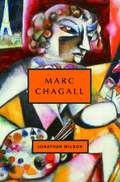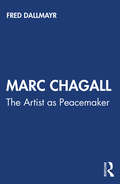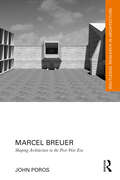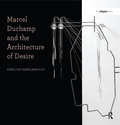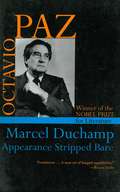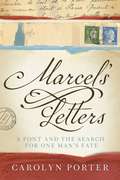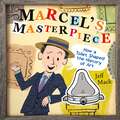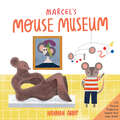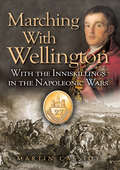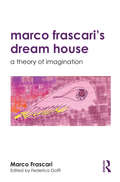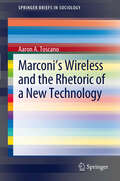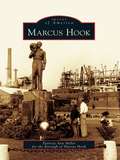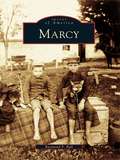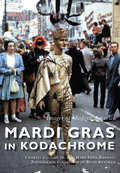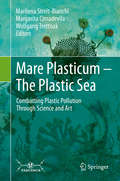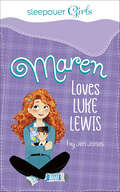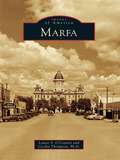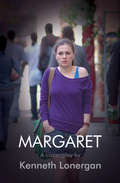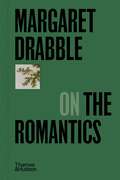- Table View
- List View
Marc Chagall (Getting to Know the World's Greatest Artists)
by Mike VeneziaDiscusses the life and work of the artist Chagall, from his birth in Russia to his death at the age of ninety-seven.
Marc Chagall (Jewish Encounters Series)
by Jonathan WilsonNovelist and critic Jonathan Wilson clears away the sentimental mists surrounding an artist whose career spanned two world wars, the Russian Revolution, the Holocaust, and the birth of the State of Israel. Marc Chagall's work addresses these transforming events, but his ambivalence about his role as a Jewish artist adds an intriguing wrinkle to common assumptions about his life. Drawn to sacred subject matter, Chagall remains defiantly secular in outlook; determined to "narrate" the miraculous and tragic events of the Jewish past, he frequently chooses Jesus as a symbol of martyrdom and sacrifice. Wilson brilliantly demonstrates how Marc Chagall's life constitutes a grand canvas on which much of twentieth-century Jewish history is vividly portrayed. Chagall left Belorussia for Paris in 1910, at the dawn of modernism, looking back dreamily on the world he abandoned. After his marriage to Bella Rosenfeld in 1915, he moved to Petrograd, but eventually returned to Paris after a stint as a Soviet commissar for art. Fleeing Paris steps ahead of the Nazis, Chagall arrived in New York in 1941. Drawn to Israel, but not enough to live there, Chagall grappled endlessly with both a nostalgic attachment to a vanished past and the magnetic pull of an uninhibited secular present. Wilson's portrait of Chagall is altogether more historical, more political, and edgier than conventional wisdom would have us believe-showing us how Chagall is the emblematic Jewish artist of the twentieth century. Visit nextbook. org/chagall for a virtual museum of Chagall images. From the Hardcover edition.
Marc Chagall: The Artist as Peacemaker (Peacemakers)
by Fred DallmayrThis book follows Chagall’s life through his art and his understanding of the role of the artist as a political being. It takes the reader through the different milieus of the nineteenth and twentieth centuries – including the World Wars and the Holocaust – to present a unique understanding of Chagall’s artistic vision of peace in an age of extremes. At a time when all identities are being subsumed into a “national” identity, this book makes the case for a larger understanding of art as a way of transcending materiality. The volume explores how Platonic notions of truth, goodness, and beauty are linked and mutually illuminating in Chagall’s work. A “spiritual-humanist” interpretation of his life and work renders Chagall’s opus more transparent and accessible to the general reader. It will be essential reading for students of art and art history, political philosophy, political science, and peace studies.
Marcel Breuer: Shaping Architecture in the Post-War Era (Routledge Research in Architecture)
by John PorosThis book tracks the development of Marcel Breuer’s aesthetic clash between uniformity and singularity through the detailed examination of his seminal buildings. Each chapter examines a specific building and puts into context Breuer’s other work and the contemporary movements/architects of the post-war era such as Surrealism, Brutalism and structural expressionism. The buildings examined include the UNESCO Headquarters in Paris, France, of 1958; the IBM Research Center in Le Gaude, France, of 1962; the Annunciation Priory in Bismark, North Dakota, of 1963; and the Atlanta Central Library of 1980. Marcel Breuer’s approach to design was inspired by the Spanish phrase, sol y sombra (sun and shadow). Sun and shadow meant for Breuer that a juxtaposition of contrasts was necessary; light glass walls and heavy concrete, masses lifted over voids, and serial precast construction resting on sculptural columns became hallmarks of Breuer’s buildings. By creating an architecture of juxtaposition, Breuer’s work can be interpreted as a surrealist recontre, as fueling a new architectural condition. A critical evaluation of Marcel Breuer’s work, this book is written for graduate students, researchers, and academics interested in his work and how it shaped the architecture of the post-war era.
Marcel Duchamp and the Architecture of Desire (Design Research in Architecture)
by Penelope HaralambidouWhile much has been written on Marcel Duchamp - one of the twentieth century's most beguiling artists - the subject of his flirtation with architecture seems to have been largely overlooked. Yet, in the carefully arranged plans and sections organising the blueprint of desire in the Large Glass, his numerous pieces replicating architectural fragments, and his involvement in designing exhibitions, Duchamp's fascination with architectural design is clearly evident. As his unconventional architectural influences - Niceron, Lequeu and Kiesler - and diverse legacy - Tschumi, OMA, Webb, Diller + Scofidio and Nicholson - indicate, Duchamp was not as much interested in 'built' architecture as he was in the architecture of desire, re-constructing the imagination through drawing and testing the boundaries between reality and its aesthetic and philosophical possibilities. Marcel Duchamp and the Architecture of Desire examines the link between architectural thinking and Duchamp's work. By employing design, drawing and making - the tools of the architect - Haralambidou performs an architectural analysis of Duchamp’s final enigmatic work Given: 1. The Waterfall, 2. The Illuminating Gas... demonstrating an innovative research methodology able to grasp meaning beyond textual analysis. This novel reading of his ideas and methods adds to, but also challenges, other art-historical interpretations. Through three main themes - allegory, visuality and desire - the book defines and theorises an alternative drawing practice positioned between art and architecture that predates and includes Duchamp.
Marcel Duchamp: Appearance Stripped Bare (Alianza Forma Ser.)
by Octavio PazOctavio Paz conveying "his awareness of Duchamp as a great cautionary figure in our culture, warning us with jest and quiet scandals of the menacing encroachment of criticism, science and even art." -New York Times Book Review
Marcel Duchamp: Second Edition (World of Art #0)
by David Hopkins Neil Cox Dawn AdesA revised and expanded edition of one of the most original books ever written on the enigmatic artist Marcel Duchamp. Genius, anti-artist, charlatan, guru, impostor? Since he arrived on the scene in 1914, Marcel Duchamp has been called all of these. Almost no other artist of the twentieth century has inspired more passion and controversy, nor exerted a greater influence on art. At the same time, Duchamp continually challenged the very nature of art and strove to redefine it as conceptual rather than as product by questioning why the medium was mostly a "retinal" experience. Always the provocateur, Duchamp never ceased to be engaged, openly or secretly, in activities and works that transformed traditional artmaking. Through his works like Fountain; Bicycle Wheel; L.H.O.O.Q.; and Nude Descending a Staircase, No. 2, Duchamp played with the idea of what art can be, opening new possibilities for future generations. This revised entry in the World of Art series, written by three leading experts on twentieth-century art, and published with support of Duchamp’s widow, is one of the most original books written on this enigmatic artist. Featuring a new chapter and preface, as well as updates throughout from specialist scholars who are active in their fields, this is the definitive introduction to Duchamp. Thoroughly illustrated, this volume combines thirty years of research by the authors and challenges history’s presumptions, misunderstandings, and pieces of misinformation about Marcel Duchamp and his legacy.
Marcel's Letters: A Font and the Search for One Man's Fate
by Carolyn PorterFinalist for the 2018 Minnesota Book AwardA graphic designer’s search for inspiration leads to a cache of letters and the mystery of one man’s fate during World War II.Seeking inspiration for a new font design in an antique store in small-town Stillwater, Minnesota, graphic designer Carolyn Porter stumbled across a bundle of letters and was immediately drawn to their beautifully expressive pen-and-ink handwriting. She could not read the letters-they were in French-but she noticed all of them had been signed by a man named Marcel and mailed from Berlin to his family in France during the middle of World War II.As Carolyn grappled with designing the font, she decided to have one of Marcel’s letters translated. Reading it opened a portal to a different time, and what began as mere curiosity quickly became an obsession with finding out why the letter writer, Marcel Heuzé, had been in Berlin, how his letters came to be on sale in a store halfway around the world, and, most importantly, whether he ever returned to his beloved wife and daughters after the war.Marcel’s Letters is the incredible story of Carolyn’s increasingly desperate search to uncover the mystery of one man’s fate during WWII, seeking answers across Germany, France, and the United States. Simultaneously, she continues to work on what would become the acclaimed P22 Marcel font, immortalizing the man and his letters that waited almost seventy years to be reunited with his family.
Marcel's Masterpiece: How a Toilet Shaped the History of Art
by Jeff MackAn engaging, kid-friendly introduction to artist Marcel Duchamp and how he turned a toilet into a famous work of art.This is the story of Marcel Duchamp and how the Dada art movement changed the way people thought about what art could be, and what could be art. From drawing a moustache on the Mona Lisa to attaching a bicycle wheel to a stool, Duchamp's work challenged long-held notions of art and how it should be made. People were amused, confused, and sometimes offended, and that was just the way Marcel Duchamp liked it.With Marcel's Masterpiece, Jeff Mack explores Duchamp's most famous provocation, and asks readers to ponder the ideas that help us see the world in new and interesting ways.
Marcel's Mouse Museum
by Hannah AbboThe Marcel's Mouse Museum is home to paintings and sculptures by the most famous mice of the last one hundred years, from Parmesan Picasso to Gouda Kahlo. Take a tour of mouse art history and styles with Curator Marcel and learn about art movements and styles like Cubism, self-portraits, Pop Art, and many more that have influenced art today. And we can&’t forget the cheesy fun facts and activities that go with them! With adorable mice drawn in famous artwork and an entertaining mix of mouse humor and history facts, Marcel's Mouse Museum is both educational and fun! Plus, each artist comes with an activity to try at home, perfect for inspiring the artist in everyone. The entire experience will be un-brie-lievable!
Marching with Wellington: With the Inniskillings in the Napoleonic Wars
by Martin CassidyCompiled from hitherto unpublished diaries and letters, this book tells of the dangers and rigors of life as experienced by the Infantry during the Napoleonic Wars. A superbly researched work by an expert historian, it captures the atmosphere of the era with total immediacy made possible only because the writers were actually there.
Marco Bellocchio
by Clodagh BrookMarco Bellocchio is one of Italy's most important and prolific directors, with a career spanning five decades. In this book, Clodagh J. Brook explores the boundaries between the public and the private, the political and the personal, and the collective and the individual as they appear in Bellocchio's films. Including work on psychoanalysis, politics, film production, autobiography, and the relationship between film tradition and contemporary culture, Marco Bellocchio touches on fundamental issues in film analysis.Brook's study interrogates what it means to make personal or anti-institutional art in a medium dominated by a late-capitalist industrial model of production. Her readings of Bellocchio's often enigmatic and perplexing work suggest new ways to answer questions about subjectivity, objectivity, and political commentary in modes of filmmaking. Relating the art of a private director to a public medium, Clodagh J. Brook's work is an important contribution to our understanding of film.
Marco Frascari's Dream House: A Theory of Imagination
by Federica Goffi Marco FrascariThis previously unpublished work is essential reading for anyone who has followed Marco Frascari’s scholarship and teachings over the last three decades. It also provides the perfect introduction for anyone new to his writings. As ever, Frascari does not offer prescriptive tools and frameworks to enact his theories of drawing and imagination; instead, he teaches how to build one’s own through individual practice. An illuminating introduction places the text in a wider context, providing the reader with a fascinating and important context and understanding to this posthumous work. Frascari's sketchbooks are reproduced faithfully in full colour to provide the reader with a remarkable insight into the design process of this influential mind.
Marconi's Wireless and the Rhetoric of a New Technology
by Aaron ToscanoThis book examines the discourse surrounding the wireless, created by the Anglo-Italian inventor Guglielmo Marconi. The wireless excited early twentieth-century audiences before it even became a viable black box technology. The wireless adhered to modernist values--speed, efficiency, militarization, and progress. Language surrounding the wireless is a form of technical communication, overlooked by today's practitioners. This book establishes a broader definition for technical communication by examining a selection of the discourse surrounding Marconi's wireless. The book's main themes are the following: 1) technical communication is all discourse surrounding technology, 2) the field of technical communication (or technical writing) should incorporate analyses of discourse surrounding technologies into its epistemology, 3) the wireless is a product of the society from which it comes (early twentieth-century Western civilization), and 4) the discourse surrounding the wireless is infused with tropes of progress--speed, efficiency, evolution, and ahistoricity.
Marcus Hook
by Borough of Marcus Hook Patricia Ann MillerMarcus Hook is the northernmost city on the Delmarva Peninsula. Incorporated in 1892, Marcus Hook was originally named for a Native American chief and was once the haunt of English pirate Edward Teach (Blackbeard). It is now best known as the home of SunOil Refinery. Thanks to its location along the Delaware River, the town prospered as residents and businesses flocked to the area. Other large businesses located here include the former American Viscose and British Petroleum. Through vintage photographs, Marcus Hook commemorates the longstanding heritage of this small community and the growth of the Delaware River waterfront.
Marcy: Early Aviation History Of Oneida County, N. Y. (Images of America)
by Raymond F. BallMarcy is not a town but rather a township made up of several hamlets, Stittville being the largest. These hamlets originated with groups of various religions and nationalities, such as Welch, Methodist, and Baptist. The one thing they all had in common was their desire to survive and prosper. The answer was in farming and all the hard work that had to be done every day. In the late 1850s, everything changed when the railroad came to town. Travel outside the farm fences became easy and enjoyable. Residents could catch the train and, in only 20 minutes, be in Utica, a whole different world, with stores and merchandise unlike anything on the farm. Today the farming has all but gone, and Marcy is largely a bedroom community with a mixture of small shops, electricity and water distribution systems, and higher education institutions.
Mardi Gras in Kodachrome (Images of Modern America)
by Charles Cassady Jr. Mary Lynn Randall Ruth KetchamAmerica's greatest party and America's most colorful city, in all their shades, shimmer here in a never-before-published 1950-1960 collection of photographs taken at New Orleans's annual Mardi Gras. Photographer Ruth Ketcham chose the revolutionary Kodachrome slide film to capture Carnival, its walking and parading krewes, bystanders, and masquers. Kodachrome's fade-resistant images preserve a bygone 1950s era, not only of Mardi Gras but also of a bustling French Quarter, alive again with Regal Beer ("Red beans and rice / And Regal on ice"), Dixieland jazz clubs, the burlesque dancers and temptations of Bourbon Street, and the shopper's paradise that was Canal Street.
Mare Plasticum - The Plastic Sea: Combatting Plastic Pollution Through Science and Art
by Marilena Streit-Bianchi Margarita Cimadevila Wolfgang TrettnakThis book, written by a multidisciplinary team of authors comprising scientists, artists and communicators, explores one of the most pressing issues of our time – the menace plastics pose to marine environments and organisms. It takes readers on a journey that begins on the beaches of Galicia, where the beach litter formed the starting point for an exhibition that combines art and science to alert the audience to the urgent need for action. The journey culminates with a short “plastic story”, which reveals a disturbing vision of the future significance of plastics for humans, and an example of how comics can deliver information to a younger audience. Along the way there is plenty of fascinating science, such as insights into the impacts of plastics and microplastics; the new marine ecosystem, known as the “plastisphere”; and the current status of the oceans, from the Arctic to the Mediterranean. The book also explores the historical developments; sustainable solutions, including the use of circular economy methodologies; and protective measures, like those being tried in China and the Far East. Lastly, it describes the role played by rivers as transport vectors for plastic, with special reference to the Danube, and to complete the picture, since most of the plastic is of terrestrial origin, it investigates problems related to microplastics in soils.
Maren Loves Luke Lewis (Sleepover Girls)
by Jen JonesThe Sleepover Girls just found out some MAJOR news. Teen pop star Luke Lewis is returning to his hometown of Valley View (which just happens to be their hometown as well) to hold a special benefit concert! Maren is his biggest fan, and she’s dead set on winning tickets from the local radio station's contest. The challenge? Create a love letter to Valley View showing your hometown pride. Maren wastes no time enlisting the Sleepover Girls’ help to make the most awesome scrapbook ever. Will her project hit the right note? Grab the companion craft book and review the pillow talk questions to be ready for your next sleepover!
Marfa
by Louise S. O'Connor Cecilia ThompsonIn the rugged High Chihuahua Desert of West Texas, Marfa lies in the northeast corner of Presidio County, 60 miles from the Mexico border. Originally established as a water stop for the Galveston, Harrisburg, and San Antonio Railroad in 1883, it soon became the county seat and heart of a thriving commercial center built around ranching. Marfa's Fort D. A. Russell, first known as Camp Albert and later Camp Marfa, has been home to numerous military units from the early 1900s through the end of World War II. This military presence, combined with the development of the famous Highland Hereford that propelled local cattle ranching to a nationally recognized level, provided the economic and social base for the community well into the 1950s. Marfa's proximity to Mexico contributes tremendously to a remarkable blend of cultures, and today the once remote frontier town has established itself as a sophisticated arts and cultural mecca.
Margaret (Books That Changed the World)
by Kenneth LonerganThe director&’s-cut screenplay of the film starring Anna Paquin from the Oscar-winning writer and director of Manchester by the Sea. This stirring drama by the Academy Award–winning director, playwright, and screenwriter Kenneth Lonergan was called &“a film of rare beauty and shocking gravity&” by Rolling Stone. Delayed for four years in post-production, the film was finally released in 2011, with a director&’s cut following on DVD in 2012. This edition includes the scripts of the full director&’s cut, along with an introduction and key tie-in art. Margaret is the story of a Manhattan teenager whose life is profoundly altered after witnessing a terrible accident. It is the extraordinary journey of an emotional teen who abides by her moral code and wants to set things right, but whose innocent ideals come crashing against the harsh realities of the adult world. It is a story of youth, love, the consequences of mistakes, and the fundamental questions of morality as faced by a teenager in an extraordinary situation. &“A triumph . . . the sort of ambitious American storytelling you find too rarely at the movies.&” —Chicago Tribune &“Extraordinarily ambitious . . . Lonergan has as much on his mind as a contemporary novelist such as Don DeLillo or Jonathan Franzen.&”—Time &“Arguably the most important American playwright of the last twenty years.&” —The New York Times
Margaret Bourke-White: Young Photographer (Childhood of Famous Americans Series)
by Montrew DunhamA fictionalized biography of the photographer and writer who was one of the original staff photographers for Life magazine and the first accredited woman war correspondent to be sent overseas during World War II.
Margaret Drabble on the Romantics (Pocket Perspectives)
by Margaret DrabbleA highly acclaimed novelist on the way in which the landscape has both influenced and been represented in British Romantic literature. Margaret Drabble on the Romantics presents an image of Britain as seen through the eyes of some of its most celebrated writers. Many of the Romantics, as well as their successors, are closely associated with particular landscapes—the Wordsworths with the Lake District, Walter Scott with the Scottish Borders, and the Bronte¨ sisters with West Yorkshire. Drabble deepens our understanding of this connection, unpacking the Romantics’ fascination with all varieties of rural landscape, from roaring seas to tranquil villages, while also exploring their writing’s subtler associations. Herself a literary luminary, Drabble illuminates how this love of place fashioned some of the Romantics’ greatest works. She considers the resonances of myth and legend, art and earlier literature that the Romantics found in places such as North Wales and Cornwall, and investigates how their writing has, in turn, shaped our visual attitudes, taste in landscape and relation to nature.
Margaret Holzmann's Iconic Knit Blankets and More: 30+ Graphic Patterns for Blankets, Pillows, Tops, and Table Runners
by Margaret HolzmannMargaret Holzmann, author of the wildly popular Geometric Knit Blankets, is back, this time with themed designs featuring cats, dogs, houses, Christmas trees and candy canes, among other highly graphic, colorful designs. 30+ patterns for blankets and pillows, plus table runners and tops featuring icons from the blanket designs—all in Margaret&’s signature style.
Margaret Mitchell's Gone With the Wind: A Bestseller's Odyssey from Atlanta to Hollywood
by John Wiley Jr. Ellen F. BrownMargaret Mitchell's Gone With the Wind: A Bestseller's Odyssey from Atlanta to Hollywood presents the first comprehensive overview of how this iconic novel became an international phenomenon that has managed to sustain the public's interest for seventy-five years. Various Mitchell biographies and several compilations of her letters tell part of the story, but, until now, no single source has revealed the full saga. This entertaining account of a literary and pop culture phenomenon tells how Mitchell's book was developed, marketed, distributed, and otherwise groomed for success in the 1930s—and the savvy measures taken since then by the author, her publisher, and her estate to ensure its longevity.

